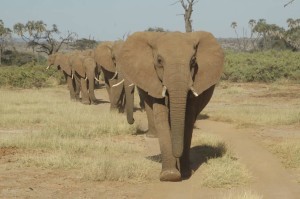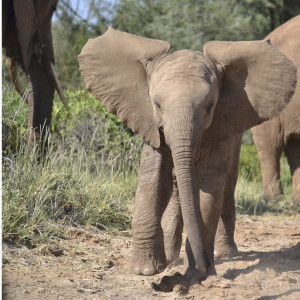Despite poaching, elephants’ social networks hold steady
by Mary Guiden | December 17, 2015 11:00 AM

While the demand for ivory has put elephants under incredible pressure from poachers, their rich social networks have remained remarkably steady. That’s according to evidence on the grouping patterns among adult female elephants living in northern Kenya over a 16-year period, which show that daughters often step up to take the place of their fallen mothers. The findings[1] are reported by researchers at Colorado State University in Current Biology on Dec. 17.
“We were surprised at just how important a mother’s associates were to her daughter’s new bonds,” said Shifra Goldenberg, lead author and PhD student in the Department of Fish, Wildlife and Conservation Biology[2] in the Warner College of Natural Resources at CSU. “In the past we’ve seen young females hanging out together that we wouldn’t expect to, but then later, as we do the analysis, we see that their mothers did know each other and spent some time together.”
Poaching remains an issue
According to estimates, poachers killed about 100,000 Africa’s elephants for their ivory between 2010 and 2012. Older and more experienced individuals are at greater risk of poaching because of the size of their tusks. As a result, the average age of adult female elephants in Kenya’s Samburu National Reserve[3] has declined significantly.

Studies of the elephants’ social structure conducted over many years have found a level of complexity that rivals that of human societies. In the new study, the researchers analyzed the patterns of elephants’ social networks over time. They also examined how elephant mothers, who hold an important role as matriarchs in elephant societies, shape their daughters’ social lives.
The research team included CSU’s George Wittemyer, associate professor in the Department of Fish, Wildlife and Conservation Biology and Save the Elephants[4] founder Iain Douglas-Hamilton, who quantified the severity of elephant poaching in a study released in 2014[5]. They found that the structure of the Kenyan elephants’ social network was maintained over time, despite a 70 percent turnover of individuals. Generally speaking, the oldest and most experienced remaining individuals stepped up to fill socially central “hubs” in the network.
Social positions foreseen by researchers
Researchers also found that they could predict the social positions of daughters based on their mothers’ role in the herd years before. That ability of daughters to fill the social roles of their mothers drove the observed network resilience. In extreme situations where families had lost most of the mature adults, elephants created new networks from previously distant connections.
“The fact that elephants are socially resilient is an important and exciting finding, showing their innate resilience to this unfortunate human pressure,” Goldenberg said. “You might expect a society centered around matriarchs to collapse with the loss of group matriarchs, but our study shows that they can adapt to these changes.”
While the findings show reason for hope, it’s clear that poaching has reached an unsustainable level, the researchers say.
“This social robustness was demonstrated across groups that experienced major and minor disruption,” Wittemyer said. “It provides optimism regarding the ability of elephants to recover from human disturbance once we manage to offer them a respite from the pressure.”
Goldenberg is also enrolled in CSU’s Graduate Degree Program in Ecology and is a Sustainability Leadership Fellow in the School of Global Environmental Sustainability[6].
This release was developed by Joseph Caputo, media relations manager for Cell Press/Elsevier, in conjunction with CSU researchers Goldenberg and Wittemyer.
- findings: http://www.cell.com/current-biology/abstract/S0960-9822(15)01366-4
- Department of Fish, Wildlife and Conservation Biology: http://warnercnr.colostate.edu/fwcb-home
- elephants in Kenya’s Samburu National Reserve: https://googleblog.blogspot.com/2015/09/walk-alongside-elephants-of-samburu.html
- Save the Elephants: http://savetheelephants.org/
- study released in 2014: http://source.colostate.edu/more-than-100k-elephants-killed/
- School of Global Environmental Sustainability: http://sustainability.colostate.edu/
Source URL: https://source.colostate.edu/despite-poaching-elephants-social-networks-hold-steady/
Copyright ©2024 SOURCE unless otherwise noted.